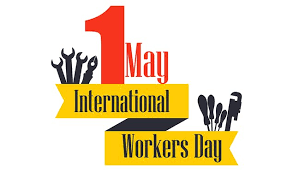
Posted On: Wednesday, May 1, 2024

A BRIEF HISTORY OF MAY DAY
International Workers’ Day, May 1st, is a day of special significance for the labour movement. It’s a day of worldwide solidarity. A time to remember past struggles and to demonstrate our hope for a better future. A day to remember that an injury to one is an injury to all.
May Day is a day of remembrance and celebration for international labour and left-wing movements. It commonly sees organized street demonstrations and marches by working people and their labour unions throughout most of the world. May Day is a national holiday in more than 80 countries and is celebrated unofficially in many others.
International Workers’ Day was originally recognized to commemorate the 1886 Haymarket Massacre in Chicago and working class struggle.
In 1884, the heart of the American labour movement was in Chicago. The Federation of Organized Trades and Labor Unions – in response to workers who were being forced to work more than twelve hours a day – passed a resolution stating that eight hours should constitute a day’s work legally from May 1, 1886. The resolution further called for a general strike to achieve this goal.
The government of the day was terrified by the increasing revolutionary nature of the Anarchist and Labour Movements and prepared accordingly. By May 1st, the movement got momentum. On May 3, 1886, police fired into a crowd of strikers at the McCormick Reaper Works Factory, killing four and wounding many. Agitators called for a mass meeting the next day in Haymarket Square to protest the brutality. The Chicago Police marched into the square and ordered the meeting to disperse. At this moment a bomb was thrown into the ranks of the police, killing one and wounding about seventy others. The police opened fire on the spectators. The subsequent riot resulted in the deaths of seven policemen and an unknown number of protesters.
Following the bombing a reign of terror swept over Chicago. Meeting halls, union offices, printing shops and private homes were raided “Make the raids first and look up the law afterwards” was the public statement of J. Grinnell, the Illinois States Attorney.
The raids and repression, backed and encouraged by the press, weakened the eight-hour day movement. A major source of worry and fear for the ruling class was removed and both the American Labour and Anarchist movements suffered set backs. The raids had solved part of the problem, now scapegoats had to be found.
Eight men, all anarchists and active union organisers stood trial for murder. No proof was offered by the state that any of the eight had anything to do with the bomb. In fact, three had not even been at the meeting and another was there with his wife and children. A biased judge and jury and a hysterical press ensured that all eight were found guilty. Their only “crimes” were their anarchist ideas, union activity and the threat these held for the ruling class. Grinnell made it clear, “Anarchy is on trial…these men have been selected… because they are leaders”.
In spite of world wide protest, four of the Haymarket Martyrs were hanged. Half a million people lined the funeral cortege and 20,000 crowded into the cemetery. In 1893, the new Governor of Illinois made official what the working class in Chicago and across the world knew all along. He pardoned the Martyrs because of their obvious innocence and because “the trial was not fair”.
In 1889, at the first congress of the Second International meeting in Paris for the centennial of the French Revolution, the American delegation proposed that May 1st be adopted as a workers’ holiday. This was to commemorate working class struggle and the “Martyrdom of the Chicago Eight”. Since then May Day has became a day for international solidarity.
May Day was formally recognized as an annual event at the International’s Second Congress in 1891.
In 1904, the International Socialist Conference called on “all Social Democratic Party organizations and trade union of all countries to demonstrate energetically on May 1st for the legal establishment of the 8-hour day, for the class demands of the proletariat, and for universal peace.” The congress made it “mandatory upon the proletarian organizations of all countries to stop work on May 1st , wherever it is possible without injury to the workers”.
In many countries, the working classes sought to make May Day an official holiday, and their efforts largely succeeded. May Day has long been a focal point for demonstrations by various labour unions, socialist, communist and anarchist groups.
In the United States and Canada, however, the official holiday for workers is Labour Day in September. This day was promoted by the Central Labor Union and the Knights of Labor, who organized the first parade in New York City. After the Haymarket Square riot in May, 1886, US President Grover Cleveland feared that commemorating Labor Day on May 1st could be- come an opportunity to commemorate the Haymarket Martyrs. Thus he moved in 1887 to support the Labor Day that the Knights of Labor supported.
Although May Day celebrations by socialist, anarchist and anti-globalization activists occurred in 1894 the government of Canada declared the first Monday in September as Canada’s official Labour Day.
May Day remains an important day for Unions and community group protest in Canada despite the official Labour Day in September. The province of Quebec holds the Celebration of the International Labour Day (Fête des travailleurs) the celebration, in Montreal, goes back to 1906.
May Day awareness is growing in Canada with workers now taking to the streets in Vancouver, Edmonton, Toronto, and Ottawa.
Location: Simcoe Street Theatre, Studio 7 - 65 Simcoe St., Collingwood
Location: The Blue Mountains Public Library Facebook Page/YouTube Page
Location: The Blue Mountains Public Library Facebook Page/YouTube Page
Location: L.E. Shore Library